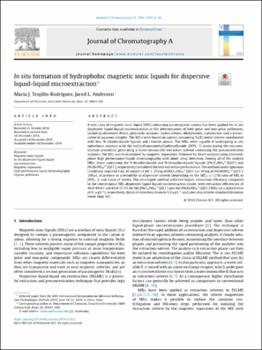In situ formation of hydrophobic magnetic ionic liquids for dispersive liquid-liquid microextraction
Date
2019Abstract
A new class of magnetic ionic liquid (MIL) containing paramagnetic cations has been applied for in situ
dispersive liquid-liquid microextraction in the determination of both polar and non-polar pollutants,
including ultraviolet filters, polycyclic aromatic hydrocarbons, alkylphenols, a plasticizer and a preservative in aqueous samples. The MILs were based on cations containing Ni(II) metal centers coordinated
with four N-alkylimidazole ligands and chloride anions. The MILs were capable of undergoing in situ
metathesis reaction with the bis[(trifluoromethyl)sulfonyl]imide ([NTf2
−]) anion during the microextraction procedure, generating a water-immiscible extraction solvent containing the preconcentrated
analytes. The MIL was then isolated by magnetic separation, followed by direct analysis using reversedphase high performance liquid chromatography with diode array detection. Among all of the studied
MILs, those containing the N-butylimidazole and N-benzylimidazole ligands ([Ni(C4IM)4
2+]2[Cl-] and
[Ni(BeIM)4
2+]2[Cl-], respectively) exhibited the best extraction performance. The method under optimum
conditions required 5 mL of sample at pH 3, 20 mg of [Ni(C4IM)4
2+]2[Cl-] or 30 mg of [Ni(BeIM)4
2+]2[Cl-],
300 L of acetone or acetonitrile as dispersive solvent (depending on the MIL), a 1:2 M ratio of MIL to
[NTf2
−], and 3 min of vortex. The developed method achieved higher extraction efficiency compared
to the conventional MIL-dispersive liquid-liquid microextraction mode, with extraction efficiencies of
46.8–88.6% and 65.4–97.0% for the [Ni(C4IM)4
2+]2[Cl-] and the [Ni(BeIM)4
2+]2[Cl-] MILs (at a spiked level
of 81 g L-1), respectively, limits of detection down to 5.2 g L-1, and inter-day relative standard deviation
lower than 16%.




